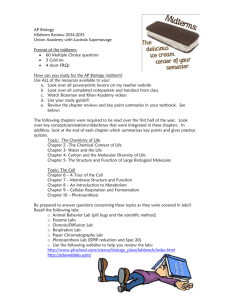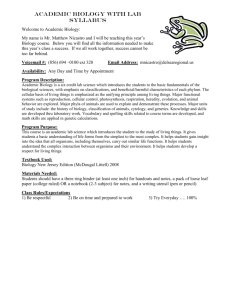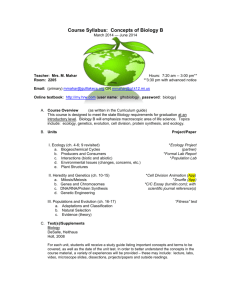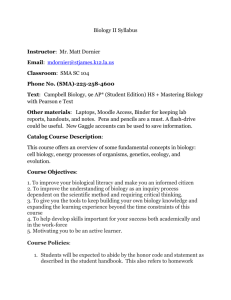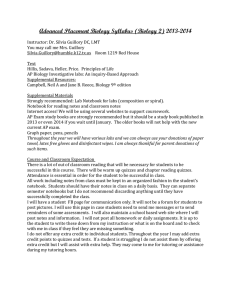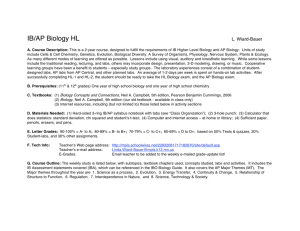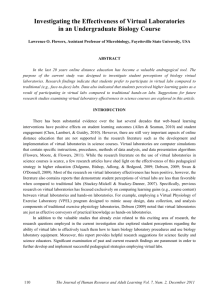Program(s) represented in this Group? STEM BIOLOGY, CHEMISTRY
advertisement
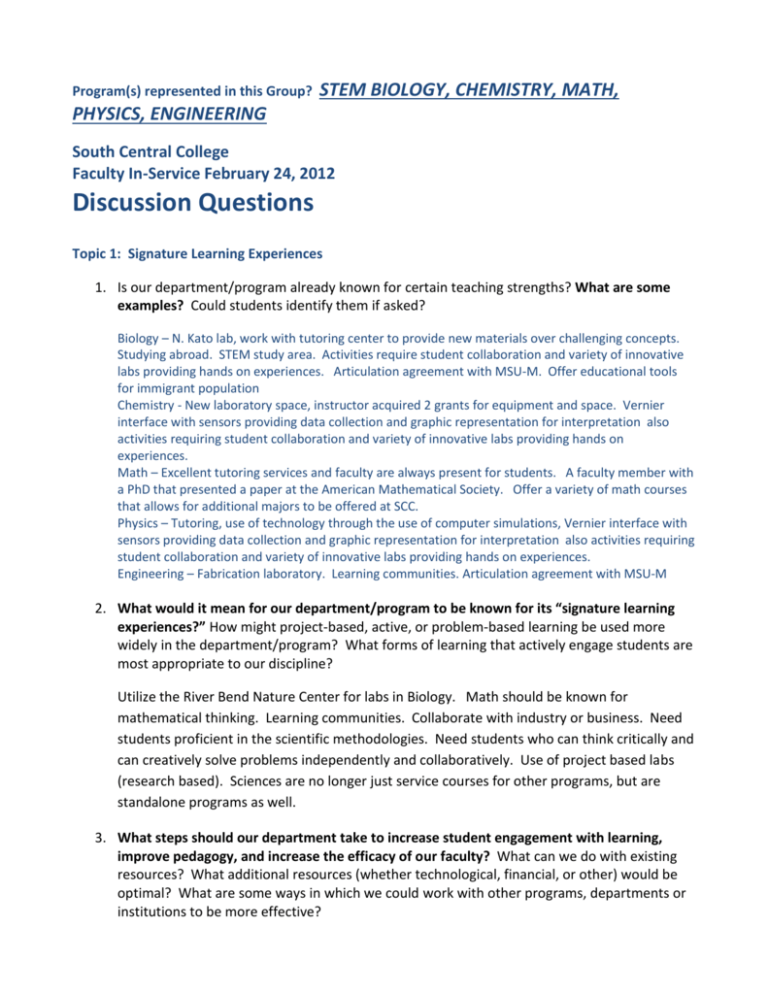
Program(s) represented in this Group? STEM BIOLOGY, CHEMISTRY, MATH, PHYSICS, ENGINEERING South Central College Faculty In-Service February 24, 2012 Discussion Questions Topic 1: Signature Learning Experiences 1. Is our department/program already known for certain teaching strengths? What are some examples? Could students identify them if asked? Biology – N. Kato lab, work with tutoring center to provide new materials over challenging concepts. Studying abroad. STEM study area. Activities require student collaboration and variety of innovative labs providing hands on experiences. Articulation agreement with MSU-M. Offer educational tools for immigrant population Chemistry - New laboratory space, instructor acquired 2 grants for equipment and space. Vernier interface with sensors providing data collection and graphic representation for interpretation also activities requiring student collaboration and variety of innovative labs providing hands on experiences. Math – Excellent tutoring services and faculty are always present for students. A faculty member with a PhD that presented a paper at the American Mathematical Society. Offer a variety of math courses that allows for additional majors to be offered at SCC. Physics – Tutoring, use of technology through the use of computer simulations, Vernier interface with sensors providing data collection and graphic representation for interpretation also activities requiring student collaboration and variety of innovative labs providing hands on experiences. Engineering – Fabrication laboratory. Learning communities. Articulation agreement with MSU-M 2. What would it mean for our department/program to be known for its “signature learning experiences?” How might project-based, active, or problem-based learning be used more widely in the department/program? What forms of learning that actively engage students are most appropriate to our discipline? Utilize the River Bend Nature Center for labs in Biology. Math should be known for mathematical thinking. Learning communities. Collaborate with industry or business. Need students proficient in the scientific methodologies. Need students who can think critically and can creatively solve problems independently and collaboratively. Use of project based labs (research based). Sciences are no longer just service courses for other programs, but are standalone programs as well. 3. What steps should our department take to increase student engagement with learning, improve pedagogy, and increase the efficacy of our faculty? What can we do with existing resources? What additional resources (whether technological, financial, or other) would be optimal? What are some ways in which we could work with other programs, departments or institutions to be more effective? All math faculty should be under one division. Each department should have a chair person to represent the department and work on the behalf of the faculty. Collaboration between departments that share stuff. Ensure faculty have the technology resources that are needed for their courses. More white boards around campus. I-pad based technology. Students need to have access to technology. Faculty should be encouraged to review select and implement new and innovative pedagogies, examples such as undergraduate research modeling method of instruction and flipped instruction. Need to have multi-institutional meetings allowing interaction between faculty of similar disciplines during workshop inservice days. Topic 2: Learning Outcomes 1. What capabilities and competencies do we expect students to have when they graduate from our department/program? Read, write and play nice. Collaborate, globalization, be skilled in grade school math (the ability to estimate and read graphs and do fractions), effective communication both written and oral, confidence, abilities to enter the job market. To be able to think critically and model real life scenarios in a way they understand and can explain. Science literacy (to be able to differentiate between junk science and true science). Demonstrate professionalism. Ability to adapt to new work environments. Ability to show up to work on time. Ability to take notes. 2. What data do we already have about learning outcomes, and how are we using them? Are there ways in which we could review outcomes data to improve learning? Collect all final exam scores for math readiness. General education assessment data was used to determine biology program requirements i.e. public speaking. Accuplacer scores to see if the students are prepared for the course. 3. What improvements should we make in our learning outcomes data or assessment practices to better assess what students learn in our department/program? Collect all and use all final exam scores for math readiness. Have better accuplacer exams driven by faculty input. Implement a science placement exam. Keeping track of alumni’s progress. Tailored general courses specific for profession (i.e. math 0085 with mechatronic examples and text). Faculty training on proper ways to write or revise CCO’s so they can base their assessment on that CCO. Appropriate pre-reqs. Cannot base success of program on graduation rates. Additional markers such as job placement should be included. Distinguish between degree seeking and non-degree seeking students when measuring program success. Realize that many students go part time for their degree and take longer to graduate. 2 Topic 3: Curricular and Course Collaboration 1. Are there ways in which new collaborations could make our courses better and our work more productive and enjoyable? We need a greater connection between math readiness and college level math. Use project based learning in engineering with other disciplines to provide broad-spectrum learning. This also provides students a chance to interact with other students providing networking. Have people working in the field to present in the class. This allows student to see how people really use the course. 2. How can we increase collaboration within the department, across the college or university, or across the system to create and share the courses and materials? Combine the engineering students with MSU-M to create a single project. Make better use of workshop days, let the faculty decide what will happen during workshop days. Create an honors course that combines math, chemistry, and physics (learning community). Work with MSU-M to develop shared biotechnology courses. Create a committee called interdisciplinary faculty that reviews CCOs and decides what materials should be shared between departments. e.g. the committee finds what math is needed in physics, bio, chem, etc., then math department puts it in its CCOs. Increase number of full time instructors and decrease turnover rate. Use common lab curriculum within the same course taught by different instructors. Have multi-college discipline meetings to collaborate with other instructors. 3. How might we redesign our e-education strategy to reduce the costs of course development and develop better courses? Hire a dedicated curriculum specialist to help faculty develop their online delivery. No online classes until its time (course is truly ready). Topic 4: Next Steps 1. What specific goals can we achieve in 2012-13? Which projects do we wish to focus on? A) We need to increase the graduation rate, and increase the retention rate, increase the production of well-educated students, increase the number of students getting jobs. B) Begin Engineering and Biology. C) Better room scheduling. D) Develop lab safety protocol E) Develop the fabrication laboratory 3 F) Create a student space to study G) Dean Nordblom’s new initiatives in the math department 2. What do we need in order to accomplish these goals? A) Limit the number of advisees assigned to advisors. Expand the academic support center. Increase number of job fairs. Assist students to create a portfolio for employment. B) Need dedicated lab space for the fabrication laboratory/physics. Department cannot achieve the goals when they have to be the marketing person for their program. Develop course curriculum for biology and engineering. C) Room assignments need to be completed by a person – not a computer. D) Need an expert (other than Al) to come in yearly to provide hazardous material training to faculty. E) Engineering has acquired a $50,000 grant for equipment through MNCEME, still need to have additional funding to purchase the required MIT equipment. F) Small dedicated rooms for studying G) Support Dean Nordblom’s initiatives in mathematics. 4
